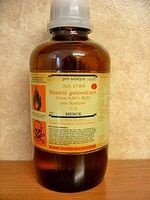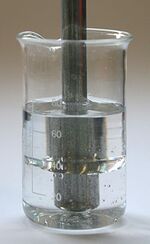Benzene
“Popping bottles in the ice, like a blizzard
When we drink we do it right gettin slizzard”
Benzene (chemical formula: C6H6) is a recreational clear liquid that chemists compare favorably with absinthe, aquavit, and Aqua Velva.
In the Hip Hop community, it is instead referred to as G6, or "purple drunk." (Or "purple drank," if one is using the pluperfect, which the Hip Hop community rarely is.)
History
Benzene was discovered by Michael "Ben" Faraday in 1825. It was a serendipitous invention, as "Uncle Ben" was instead trying to achieve miniaturization. Those experiments were eventually successful and gave us the microfarad.
Although everyone knew benzene, no one knew what it was. Chemistry spent the next thirty odd years in odd experiments to figure out what was on the end. In August 1858, however, Kekulé had a fateful nightmare about a snake chasing its own tail.
Sigmund Freud believed that this nightmare had no particular meaning, though Kekulé's cat often chased its own tail, which was more productive than waiting for Kekulé to rouse himself from the laboratory and feed him; the cat had become scrawny but not overtly snake-like. However, sometimes a snake is merely a snake.
Nevertheless, Kekulé published a pathbreaking paper — his I Have a Dream paper (Où est ma bouteille de benzène? in the original French), which suggested that there was nothing on the end at all, and that benzene went on forever. Chemists embraced this conclusion as comparable but superior to their prior one, which was simply, "Don't kill the job!"
Eventually they found that benzene is the key to a diverse chemical family. Indeed, in August 1855, Wilhelm Hofmann used the word "aromatic" to describe it, after a property of members of his own family.
Composition
Faraday first isolated benzene as the oily residue (or, as he described it, "gunk") derived from producing gaslight gas. He initially named it plantagenet of hydrogen.
These days, benzene is produced by coal-tar distillation. It has a pleasant odor, although excessive affection for the odor, if it results in habitual huffing of the colorless liquid, can lead one to write nonsense.
Benzene is not to be confused with benzine, which is something altogether different, as is pie as well. It is fine, however, to confuse it with benzol, because it is benzene.
Early uses
The first commercial use of benzene was as an after-shave lotion. Its popularity persisted until the moment people realized how deadly it was — and longer than that, among "creatures of habit." Thereafter, it was used as a paint stripper, a degreaser of metal, a spot remover, and to produce Sanka. This use was discontinued, however, and exposure to high levels of benzene in Chem Lab ended around 1970, leaving subsequent U.S. First Ladies to obsess about salt instead.
The extreme utility of benzene owes to the fact that one can hang not only never-ending scientific research off it, but many other molecules too. The researcher can publish uncountable papers after discovering which of the substances explode and which ones merely burn intensely. Benzene has been called the Tinkertoy of chemistry (mercury being its Silly Putty).
Benzene today
Benzene can be produced by refining hydrocarbons in a process called steam cracking. Many in the Hip Hop community, perhaps after huffing too much benzene, believe they can see "steam crackers," which they refer to as "spooks."
Toluene is a popular, aromatic hydrocarbon that is related to benzene. Toluene is used to make saccharine, which is 500 times sweeter than sugar, and trinitrotoluene (TNT), which is at least that much more explosive than a sugary milkshake. Prof. Mick Jagger established that the chemical formula for toluene is CH3CH3CH3CH3anges.
Benzene has thousands of uses, but the most lucrative uses are in public health scares. It is found in soda pop, bottled water, and cigarette smoke. These health scares persist, which is good news for the researcher, even though science has shown that about one-third of inhaled benzene is exhaled in a matter of hours; that most of the rest passes out unchanged in the urine, and the remainder is right there in the subject's cadaver, no problem.
Nevertheless, there are many lucrative careers asserting that the only safe level is zero, pulling workers off the assembly line to be measured, and banning things. This writer has just devised a new way to make product labels really revolting, and will be sending it to a journal shortly. After perhaps just one more snort.
Benzene ring
The benzene ring (or "wearable benzene") was the most profound fashion statement made by 20th-century chemists. It is often worn on the fourth (or "ring") finger, like any other ring, but may be used in various skin piercings, where they look even more revolting than public-safety labels on popular addictive products. The benzene-ring piercing is only seen whenever the chemist's real goal is to horrify his parents.
See also
| Featured version: 26 June 2014 | |
| This article has been featured on the main page. — You can vote for or nominate your favourite articles at Uncyclopedia:VFH. | |




